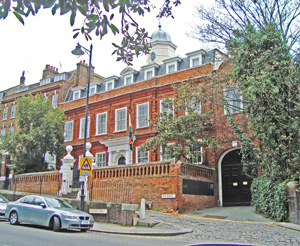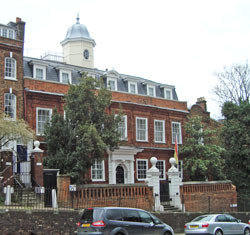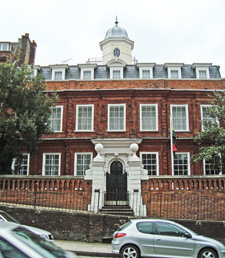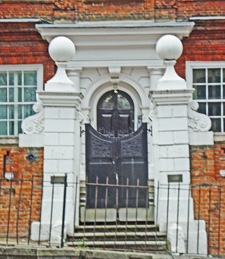Convalescent Home for Children
Cromwell House, 104 Highgate Hill, N6 5HE
Medical
dates:
Medical
character:
Convalescent
From the time it had opened in
1852, clinicians at the Hospital for Sick Children in Great Ormond
Street arranged to send children to convalescent homes in the
countryside (Mitcham) or the seaside (Brighton, Eastbourne, Margate and
Torquay) before finally discharging them. In this way, acute beds
were freed up while the children were spared having to return to their
poor, overcrowded homes before they were fully recovered.
Most convalescent homes, however, did not accept children under the age of 4 years. Thus, in 1868, the Hospital governors negotiated a 70-year lease on Cromwell House, a former boarding school for boys, for use as a convalescent home where very young children could be sent. The annual rent was to be £250; a further £3,000 was spent in refurbishing the accommodation.
The Convalescent Home for Children opened in June 1869 with 40 beds. Children with infectious or contagious diseases were excluded, as were those with epilepsy, mental illness or deficiency, and those who needed much care during the nights.
The staff consisted of a Lady Superintendent, a senior nurse, 2 assistant nurses, a convalescent nurse (teacher), a cook, a kitchen maid, 2 housemaids and a porter, who also served as a gardener.
Each nurse worked a 12-hour day, looking after 9 to 12 children. The day began at 07.30, when the little patients were washed and dressed. Their temperatures were taken, medicine given, wounds dressed and their beds made. Nurses' duties included serving the meals, cleaning the ward, washing bandages and rinsing soiled bed linen. The children had their tea at 16.00, after which they were put to bed. Only one nurse was on duty at night, from 21.30 until 07.30.
A physician and a surgeon from the main hospital attended twice a week. The clinicians were keen that the children spent as much time as possible in the open air. The garden, with its vast lawns, also contained a playground with swings and slides. The children were visited regularly by the ladies of Highgate, who schooled them in reading and writing.
Each Thursday a nurse took those children who had recovered back to Great Ormond Street, returning to Highgate with more convalescents.
The Home, originally intended to care for both in-patients and out-patients, was used mainly for children admitted to the parent Hospital - their prescribed treatment being the fresh air of Highgate. Parents were expected to pay 2 shillings and 6 pence (13p) towards the cost of transport to and from Highgate, and 6 pence (3p) a week towards their child's laundry - prohibitive charges for most of London's poor.
From 1870 parents were permitted to visit their children on Sunday afternoons.
During the year of 1885 some 250 children received care at the Home - of whom 98 were convalescents and 152 chronically ill.
In 1887 a wing was added, which contained a further 12 beds. The Home then had 51 beds - 20 for very young convalescents, 12 for those with long-term medical conditions and 20 for those with chronic illness recovering from surgery.
By the early 1920s the old house, built around 1637, was deemed no longer suitable for use as a convalescent home. In 1924 the remainder of the lease was sold to the Mothercraft Training Society and the Home closed.
In 1927 a new mansion - Tadworth Court - became the convalescent home for the Hospital for Sick Children.
Most convalescent homes, however, did not accept children under the age of 4 years. Thus, in 1868, the Hospital governors negotiated a 70-year lease on Cromwell House, a former boarding school for boys, for use as a convalescent home where very young children could be sent. The annual rent was to be £250; a further £3,000 was spent in refurbishing the accommodation.
The Convalescent Home for Children opened in June 1869 with 40 beds. Children with infectious or contagious diseases were excluded, as were those with epilepsy, mental illness or deficiency, and those who needed much care during the nights.
The staff consisted of a Lady Superintendent, a senior nurse, 2 assistant nurses, a convalescent nurse (teacher), a cook, a kitchen maid, 2 housemaids and a porter, who also served as a gardener.
Each nurse worked a 12-hour day, looking after 9 to 12 children. The day began at 07.30, when the little patients were washed and dressed. Their temperatures were taken, medicine given, wounds dressed and their beds made. Nurses' duties included serving the meals, cleaning the ward, washing bandages and rinsing soiled bed linen. The children had their tea at 16.00, after which they were put to bed. Only one nurse was on duty at night, from 21.30 until 07.30.
A physician and a surgeon from the main hospital attended twice a week. The clinicians were keen that the children spent as much time as possible in the open air. The garden, with its vast lawns, also contained a playground with swings and slides. The children were visited regularly by the ladies of Highgate, who schooled them in reading and writing.
Each Thursday a nurse took those children who had recovered back to Great Ormond Street, returning to Highgate with more convalescents.
The Home, originally intended to care for both in-patients and out-patients, was used mainly for children admitted to the parent Hospital - their prescribed treatment being the fresh air of Highgate. Parents were expected to pay 2 shillings and 6 pence (13p) towards the cost of transport to and from Highgate, and 6 pence (3p) a week towards their child's laundry - prohibitive charges for most of London's poor.
From 1870 parents were permitted to visit their children on Sunday afternoons.
During the year of 1885 some 250 children received care at the Home - of whom 98 were convalescents and 152 chronically ill.
In 1887 a wing was added, which contained a further 12 beds. The Home then had 51 beds - 20 for very young convalescents, 12 for those with long-term medical conditions and 20 for those with chronic illness recovering from surgery.
By the early 1920s the old house, built around 1637, was deemed no longer suitable for use as a convalescent home. In 1924 the remainder of the lease was sold to the Mothercraft Training Society and the Home closed.
In 1927 a new mansion - Tadworth Court - became the convalescent home for the Hospital for Sick Children.
Present status (March 2009)
The Mothercraft Training Society bought the freehold of the property and later built a hostel - the Princess Elizabeth of York Hostel - in its grounds.
In 1953 the Society sold Cromwell House to the Church of England Zenana Missionary Society. In 1970 it was sold to the Montfort Missionaries, a Roman Catholic order.
Today the Grade I listed building is the consular and business section of the Ghana High Commission.

The 17th century mansion had once been the home of General Henry Ireton and his wife Bridget, the eldest daughter of Oliver Cromwell.

The house, as seen from the west.

The main entrance is on The Bank, a raised walkway along the northeast side of Highgate Hill (above and below).

(Author unstated) 1885 Hospital for Sick Children. British Medical Journal 1 (1328), 1144.
(Author unstated) 1887 Hospital for Sick Children, Great Ormond Street. British Medical Journal 1 (1382), 1416.
(Author unstated) 1925 (Untitled). British Journal of Nursing (May), 92.
http://news.bbc.co.uk
http://trove.nla.gov.au
http://viewfinder.english.heritage.org.uk
www.aim25.ac.uk
www.bbc.co.uk
www.british-history.ac.uk
www.flickr.com
www.gosh.nhs.uk
www.hampsteadheath.net
www.haringey.gov.uk
www.hharp.org (1)
www.hharp.org (2)
www.hharp.org (3)
Return to home page